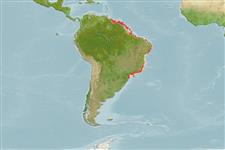Environment: milieu / climate zone / depth range / distribution range
Ekologi
marina; sötvatten; brackvatten; anadrom (Ref. 26213); djupintervall 1 - 50 m (Ref. 189). Tropical; 9°N - 27°S, 61°W - 33°W (Ref. 189)
Western Atlantic: Orinoco delta in Venezuela south to Ponta da Cotinga, Paraná coast of Brazil.
Length at first maturity / Size / Vikt / Age
Maturity: Lm 9.4, range 7 - ? cm
Max length : 18.0 cm TL hane/ej könsbestämd; (Ref. 102462); common length : 9.0 cm TL hane/ej könsbestämd; (Ref. 5217); publicerad maxvikt: 32.00 g (Ref. 118626)
Taggstrålar i ryggfenan (totalt) : 0; Mjukstrålar i ryggfenan (totalt) : 14 - 17; Taggstrålar i analfenan: 0; Mjukstrålar i analfenan: 19 - 26. Body moderately elongate and compressed (Ref. 189). Snout short, about 2/3 eye diameter; maxilla relatively long, tip bluntly rounded, reaching to pre-operculum; gill cover canals of walkeri-type (Ref. 189). Anal fin fairly long, its origin below about middle of dorsal fin base. A broad silver stripe along flank, equal or greater than eye diameter below dorsal fin (Ref. 189).
A schooling species found inshore. Most likely anadromous, entering estuaries and freshwater. Feeds on crustacean larvae or small invertebrates (Ref. 12225). Female maximum length from Ref. 71685.
Both sexes at maturity have a large amount of visceral and intermuscular fat (Ref. 189). Spawn in school (Ref. 205).
Whitehead, P.J.P., G.J. Nelson and T. Wongratana, 1988. FAO Species Catalogue. Vol. 7. Clupeoid fishes of the world (Suborder Clupeoidei). An annotated and illustrated catalogue of the herrings, sardines, pilchards, sprats, shads, anchovies and wolf-herrings. FAO Fish. Synop. 125(7/2):305-579. Rome: FAO. (Ref. 189)
IUCN Red List Status (Ref. 130435: Version 2024-2)
Threat to humans
Harmless
Human uses
Fiskeri: mindre kommeriell
Verktyg
Special reports
Download XML
Internet-källor
Estimates based on models
Preferred temperature (Ref.
123201): 24.5 - 27.8, mean 27.2 °C (based on 68 cells).
Phylogenetic diversity index (Ref.
82804): PD
50 = 0.5000 [Uniqueness, from 0.5 = low to 2.0 = high].
Bayesian length-weight: a=0.00537 (0.00470 - 0.00614), b=3.13 (3.09 - 3.17), in cm total length, based on LWR estimates for this species (Ref.
93245).
Trofisk nivå (Ref.
69278): 3.1 ±0.30 se; based on food items.
Resiliens (Ref.
120179): Hög, lägsta populationsfördubblingstid mindre än 15 månader (Fec=20,202).
Fishing Vulnerability (Ref.
59153): Low vulnerability (10 of 100).
Nutrients (Ref.
124155): Calcium = 273 [153, 637] mg/100g; Iron = 1.9 [1.1, 3.4] mg/100g; Protein = 18.3 [16.9, 19.7] %; Omega3 = 0.306 [0.154, 0.612] g/100g; Selenium = 41.1 [18.3, 94.0] μg/100g; VitaminA = 27.4 [8.1, 73.8] μg/100g; Zinc = 2.03 [1.39, 3.01] mg/100g (wet weight);
